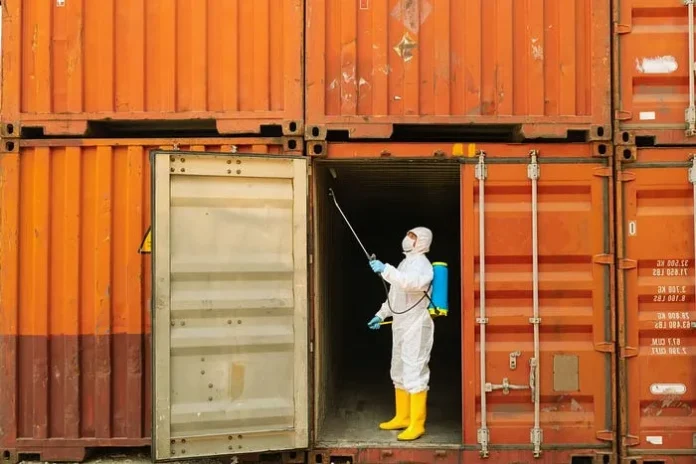In the global trade environment, maintaining the integrity and quality of goods during transit is paramount. Export fumigation services play a crucial role in safeguarding shipments from pest infestations and ensuring compliance with international regulations. This comprehensive guide delves into the importance of export fumigation, its processes, benefits, and how to select the best service provider, like Pink City Pest Control and rpcs, renowned for offering the best export fumigation services
Understanding Export Fumigation
Export fumigation is a pest control method used to eliminate pests from goods and commodities destined for international markets. It involves the application of fumigants—chemical gases that penetrate and eliminate pests at various life stages, including eggs, larvae, and adults. This process ensures that shipments are free from harmful insects and pests that could jeopardize the quality of the goods and pose a threat to the importing country’s ecosystem.
Importance of Export Fumigation
- Compliance with International Regulations: Many countries have stringent quarantine regulations to prevent the introduction of foreign pests. Export fumigation helps meet these regulatory requirements, ensuring that shipments are accepted without delays or penalties.
- Protection of Goods: Pests can cause significant damage to goods during transit, leading to financial losses. Fumigation protects goods such as agricultural products, wooden items, and textiles from infestation, preserving their quality.
- Safeguarding Public Health and Environment: Some pests are vectors for diseases or can cause ecological imbalances. Export fumigation prevents the spread of these pests, protecting public health and the environment of the importing country.
The Fumigation Process
- Inspection: Before fumigation, a thorough inspection of the shipment is conducted to identify the type and extent of pest infestation. This step helps determine the appropriate fumigant and concentration.
- Sealing: The shipment is sealed in a gas-tight enclosure, such as a container or a fumigation chamber, to contain the fumigant and ensure effective penetration.
- Fumigant Application: The chosen fumigant is introduced into the enclosure. Common fumigants include methyl bromide, phosphine, and sulfuryl fluoride. The application is done carefully to achieve uniform distribution.
- Exposure Period: The shipment is exposed to the fumigant for a specified period, allowing the gas to penetrate and eliminate pests at all life stages. The exposure time varies based on the type of fumigant, the nature of the goods, and the level of infestation.
- Aeration: After the exposure period, the enclosure is ventilated to remove any residual fumigant. This step ensures that the goods are safe for handling and transportation.
- Certification: Once the fumigation process is complete, a certificate of fumigation is issued, indicating compliance with international pest control standards. This certificate is essential for customs clearance at the destination port.
Choosing the Best Export Fumigation Service
Selecting a reliable export fumigation service provider is crucial for ensuring the effectiveness and safety of the process. Here are key factors to consider:
- Experience and Expertise: Choose a company with a proven track record in export fumigation. Experienced providers like Pink City Pest Control and rpcs have the knowledge and skills to handle diverse types of shipments and pest challenges.
- Compliance with Regulations: Ensure that the service provider complies with international fumigation standards and regulations. They should be accredited and licensed to perform fumigation services.
- Use of Safe and Effective Fumigants: The fumigation company should use approved fumigants that are effective against a wide range of pests and safe for the environment and human health.
- Certification and Documentation: A reputable fumigation service should provide proper certification and documentation after the process, facilitating smooth customs clearance.
- Customer Reviews and References: Check customer reviews and ask for references to gauge the quality of service provided. Positive feedback from previous clients indicates reliability and professionalism.
Why Choose rpcs for Export Fumigation?
rpcs, a leading name in the pest control industry, offers top-notch export fumigation services tailored to meet the needs of global trade. Here’s why rpcs stands out:
- Expertise: With years of experience in pest control, rpcs has honed its fumigation techniques to ensure maximum efficacy and safety.
- Compliance: rpcs adheres to all international fumigation standards, providing clients with the assurance of regulatory compliance.
- Advanced Methods: Utilizing state-of-the-art fumigants and equipment, rpcs guarantees thorough pest elimination without compromising the integrity of the goods.
- Certification: Post-fumigation, rpcs issues comprehensive documentation, including certificates of fumigation, easing the customs clearance process.
- Customer Satisfaction: Committed to excellence, rpcs has garnered positive reviews for its reliable and professional services.
Conclusion
Export fumigation is a critical aspect of international trade, ensuring that shipments are pest-free and compliant with regulations. By choosing a reputable provider like rpcs or Pink City Pest Control, businesses can protect their goods, safeguard public health, and contribute to environmental preservation. Understanding the fumigation process and selecting the best service provider are key steps toward successful and hassle-free global trade operations.



